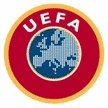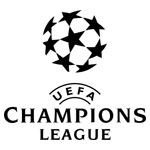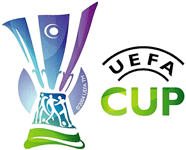
|

|
This page was the main page of the 2005/2006 season. All text has to be interpreted within that context. No changes are applied.
On this site you will find everything about the calculation of coefficients and rankings used for the qualification and seeding of teams for the Champions League and the UEFA Cup. There are no data on individual matches other then the results. Results and qualification data for the UEFA Intertoto Cup are not available at this site.
Specific data for the qualification of teams and formats of the Champions League and UEFA Cup for the 2005/2006 season can be found at the pages below.
- Qualification 2005/2006 (list of teams per country)
- Seeding Champions League 2005/2006
- Seeding UEFA Cup 2005/2006
- Calendar 2005/2006

Champions League
The Champions League contains 32 teams in the group stage, and is be preceeded
by three qualifying stages. The champions of all countries enter the Champions
League, but high ranked countries can send up to 4 teams. Some teams of high
ranked countries are directly qualified for the group stage, while others have
to play qualifying rounds.
See wikipedia
for more general info.
| CHAMPIONS LEAGUE | ||
|---|---|---|
| 1st Qualifying Round | July | 24 champions from countries ranked 26 or lower |
| 2nd Qualifying Round | Jul-Aug |
involving 28 teams: 12 winners from 1st qualifying round 10 champions from countries ranked 16-25 6 second-placed teams from countries ranked 10-15 |
| 3rd Qualifying Round | August |
involving 32 teams: 14 winners from 2nd qualifying round 6 champions from countries ranked 10-15 3 second-placed teams from countries ranked 7-9 6 third-placed teams from countries ranked 1-6 3 fourth-placed teams from countries ranked 1-3 |
| Group Stage | Sep-Dec |
involving 8 groups of 4 teams each: 16 winners from 3rd qualifying round 9 champions from countries ranked 1-9 6 second-placed teams from countries ranked 1-6 1 defending cup holder |
| Play-offs | Feb-May |
involving 16 teams: 8 group second-placed teams and 8 winners from group stage play the 2nd round, the quarter finals, the semi finals, and the final |
 Losing teams in the 3rd qualifying round enter the 1st round of the UEFA Cup,
and third-placed teams from the group stage enter the 3rd round of the UEFA Cup.
Losing teams in the 3rd qualifying round enter the 1st round of the UEFA Cup,
and third-placed teams from the group stage enter the 3rd round of the UEFA Cup.
In June 2005 UEFA decided (see 1 and 2) that the defending cup-holder always takes part. If the defending cup-holder does not finish in a qualifying place in their domestic competition they will come in at the expense of the last-placed side of that association. But there will be a special exemption in the unlikely event of a country with one Champions League spot winning the competition but failing to win their own domestic league. In August 2005 this uefadirect article states that this will only increase the number of places that an association has in the UEFA competitions if the title-holders do not qualify for these competitions through their domestic league or if their association has only one Champions League berth.
My interpretation of the above press releases is as follows:
- The Champions League title holder always takes part.
- The maximum number of Champions League teams from one association remains 4, which implies that if the Champions League title holder is from one of the top-3 ranked countries and did not qualify for the Champions League, the 4-th placed team of that association has to take part in the UEFA Cup.
- If the Champions League title holder already qualified for the UEFA Cup they will not be replaced by an extra team from that association, except for associations ranked 16 or below.
If the defending cup holder already qualified directly for the group stage of the Champions League, the champion of the 10th country on the country ranking list will gain direct access to the group stage, the champion of the 16th country on the country ranking list will gain direct access to the 3rd qualifying round, and the champions of the 26th and 27th country on the country ranking list will gain direct access to the 2nd qualifying round. Similar changes are made if the cup holder already qualified directly for one of the qualification rounds, or if the cup holder did not qualify directly but is from one of the top three ranked countries. (see above for possible changes after 2005)
If in the group stage of the Champions League two or more teams finish equal on points after all the group matches have been played, the following criteria are applied to determine the group rankings:
- Higher number of points obtained in the matches between the teams in question
- Superior goal difference from the matches between the teams in question
- Higher number of goals scored away from home in the matches between the teams in question
- Superior goal difference from all group matches played
- Higher number of goals scored
- Coefficient points accumulated by the club in question, as well as its association, over the previous five seasons

UEFA Cup
The UEFA Cup is a competition for the runners-up and the Cup Winners of each
country, some teams expelled from the Champions League, the best teams of the
Intertoto Cup,
and teams from countries who top the UEFA Fair Play competition.
See wikipedia
for more general info.
| UEFA CUP | ||
|---|---|---|
| 1st Qualifying Round | Jul-Aug |
involving 56 teams: 25 Cup Winners from countries ranked 25-49 25 second-placed teams from countries ranked 25-49 3 teams of the Fair Play competition 1 Cup Winner of Liechtenstein 2 champions of Andorra and San Marino |
| 2nd Qualifying Round | August |
involving 64 teams: 28 winners from 1st qualifying round 14 Cup Winners from countries ranked 11-24 9 second-placed teams from countries ranked 16-24 13 third-placed teams from countries ranked 9-21 |
| Round 1 | September |
involving 80 teams: 32 winners from the qualifying round 10 Cup Winners from countries ranked 1-10 2 third-placed teams from countries ranked 7-8 5 fourth-placed teams from countries ranked 4-8 8 fifth-placed teams from countries ranked 1-8 3 sixth-placed teams from countries ranked 1-3 16 teams eliminated from the 3rd qualifying round of the Champions League 3 Intertoto teams 1 defending cup holder |
| Group stage | Oct-Dec |
involving 8 groups of 5 teams each: 40 winners of the first round |
| Round 3 | February |
involving 32 teams: 24 first-placed, second-placed, and third-placed teams from the group stage 8 third-placed teams from the group stage of the Champions League |
| Round 4 | March |
involving 16 teams: 16 winners of the third round |
| Play-offs | April-May |
involving 8 teams: 8 winners of the fourth round play the quarter finals, the semi finals, and the final |
 If the cup winner of a country also qualifies for the Champions League, then the
losing team of the cup final is qualified for the UEFA Cup. If both cup
finalists qualify for the Champions League, then an additional team based on
league position will be qualified. However, the losing cup finalist does not get
the UEFA Cup cup-winner spot, but is treated as a league entrant. The 'cup-
winner' spot of that country goes to the team with the highest league position.
In some countries (England and France) the last league entrant position is given
to the League Cup Winner.
If the cup winner of a country also qualifies for the Champions League, then the
losing team of the cup final is qualified for the UEFA Cup. If both cup
finalists qualify for the Champions League, then an additional team based on
league position will be qualified. However, the losing cup finalist does not get
the UEFA Cup cup-winner spot, but is treated as a league entrant. The 'cup-
winner' spot of that country goes to the team with the highest league position.
In some countries (England and France) the last league entrant position is given
to the League Cup Winner.
The place for the defending cup holder is only used when that team has not otherwise qualified for either the Champions League or the UEFA Cup. If this place is not used then the cup winner of the 11th country on the country ranking list will gain direct access to the 1st round round, and the cup winners of the 25th and 26th country on the country ranking list will gain direct access to the 2nd qualifying round.
If two or more teams are equal on points on completion of all the group matches, the following criteria will be applied to determine the rankings:
- superior goal difference from all group matches played;
- higher number of goals scored;
- higher number of goals scored away;
- higher number of coefficient points accumulated by the club in question, as well as its association, over the previous five seasons
UEFA Country Ranking
The basis for the UEFA rankings is the performance of teams in the
European Cups during a five year period. During that period each team
gets two points for a win and one point for a draw.
From 1999 on these points are halved for qualification matches: one
point for a win and half a point for a draw.
One bonus point is allocated for reaching the quarter final,
the semi final and the final.
Reaching the group stage of the Champions League yields three bonus points
(before 1996: 2 points, from 1996-2004: 1 point). As of the 2004/05 season
teams qualifying for the first knock-out round of the Champions League will
be awarded with an extra bonus point.
The so-called UEFA coefficients are calculated by taking an average, based
on the total number of points divided by the total number of teams of
each country.
The UEFA country ranking is computed by the sum of 5 coefficients in the
last 5 years.
for an example of such a ranking list. To determine the participants in
the Champions League and the UEFA Cup the last year ranking is used,
because each country should know at the start of the season how many
places it disposes.
UEFA Team Ranking
The UEFA team coefficients are calculated as the sum of the number
of points of each individual team, and 33% of the country coefficient.
Before 2004 the contribution of the country coefficient was 50%.
For the calculation of the team coefficients games played in
qualifying rounds are not taken into account.
The UEFA team ranking is computed by the sum of 5 coefficients in the last 5 years. In this list the yellow lines with country information indicate the lowest possible value for a team of that country (even if that team didn't play any game in the last five years). The most recent team ranking is used for seeding of clubs for draws in the Champions League and the UEFA Cup.
Before 1999 a number of strong teams in the UEFA Cup were seeded such that those teams do not meet in the first two rounds. To determine these teams, the sum of the ratio of the number of points achieved, divided by the number of games played by each team, was calculated for the past five years.